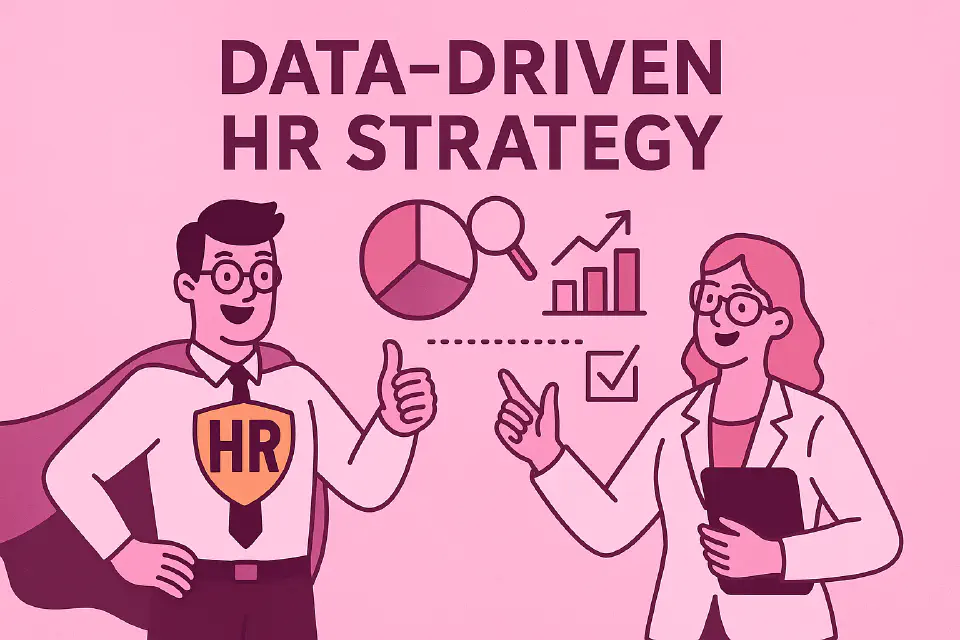
Data-Driven HR Strategy
Gut feeling isn’t strategy. A modern HR strategy relies on data to diagnose, decide, and deliver business value.
Data is no longer a back-office tool. In modern HR strategy, it’s the engine that drives everything from headcount planning to culture diagnostics.
Yet many HR teams still struggle to move from reporting metrics to strategic insight. Let’s unpack how a truly data-driven HR strategy works—and why it’s essential for long-term success.
What Is a Data-Driven HR Strategy?
A data-driven HR strategy is an approach where decisions about people, processes, and policies are guided by evidence, not assumptions.
This includes:
- Quantitative and qualitative data from across the employee lifecycle
- Predictive models to forecast outcomes
- Dashboards and KPIs tied to business objectives
- A culture of evidence-based decision-making
It’s not about collecting more data—it’s about using the right data to ask better questions and make smarter strategic bets.
Strategic Use of HR Data
HR data can be mapped across four levels of maturity:
- Descriptive – What happened?
- Diagnostic – Why did it happen?
- Predictive – What’s likely to happen next?
- Prescriptive – What should we do about it?
Most HR functions still operate at levels 1 and 2. But strategic HR needs levels 3 and 4 to:
- Identify emerging workforce risks
- Model workforce scenarios
- Prioritize high-impact HR initiatives
- Justify investments in people strategy
Linking Data to Business Goals
Data-driven HR isn’t just about HR. It’s about the business.
That means HR metrics must be:
- Aligned with business outcomes (e.g., productivity, innovation, revenue per FTE)
- Actionable at both strategic and operational levels
- Tracked consistently to measure ROI on HR interventions
Common aligned KPIs include:
- Time-to-productivity (linked to onboarding success)
- Revenue per employee (linked to workforce design)
- Internal mobility rate (linked to succession planning)
- Net Promoter Score (NPS) or eNPS (linked to engagement and retention)
Data Across the Employee Lifecycle
A strategic HR team builds a data architecture that spans the entire lifecycle:
| Phase | Example Data Sources |
|---|---|
| Hiring | Candidate conversion, source quality, CPH |
| Onboarding | Time to productivity, early attrition |
| Development | Learning hours, promotion velocity, 360 feedback |
| Performance | Rating distribution, calibration data |
| Engagement | Pulse surveys, exit interviews, eNPS |
| Retention | Turnover trends, flight risk models |
| Exit | Exit reason analytics, tenure patterns |
This data is not siloed—it’s interconnected to build models of workforce health and strategic capability.
Building Analytics Capability in HR
To become data-driven, HR needs both tools and skills.
Key building blocks:
- Modern HRIS and analytics platforms (e.g. Workday, Visier, SAP SuccessFactors)
- Data governance policies (privacy, compliance, ethical AI use)
- Upskilling HR staff in data literacy, storytelling, and decision-making
The Role of Predictive and Prescriptive Analytics
Advanced analytics can reshape how HR contributes:
- Flight risk models help reduce regrettable turnover.
- Succession risk analysis maps readiness across critical roles.
- Skill gap forecasting enables strategic reskilling investments.
- Scenario modeling supports workforce planning under uncertainty.
These tools don’t replace judgment—they enhance it.
Building a Culture of Evidence-Based HR
Culture matters. Even the best analytics fail without leadership buy-in and a mindset shift from intuition to insight.
To build a data-informed culture:
- Include data in every HR decision memo or proposal.
- Train leaders to ask for evidence and interpret HR reports.
- Celebrate wins tied to data-informed interventions.
- Use storytelling to make data compelling and actionable.
Conclusion
A data-driven HR strategy isn’t a tech upgrade—it’s a mindset upgrade. It transforms HR from an advisory service to a strategic engine that helps the business navigate complexity and uncertainty.
HR teams that invest in analytics capabilities, embed data into decision-making, and align metrics to strategy will not only earn a seat at the table—they’ll shape the table itself.
The next step? Building the governance structures and operating models that sustain strategic HR over time.